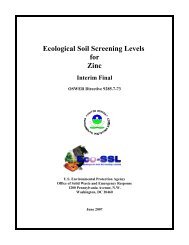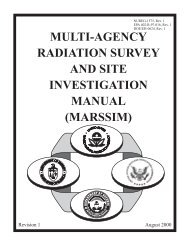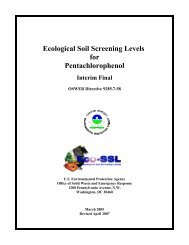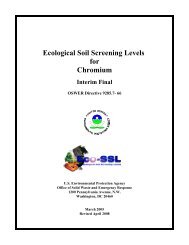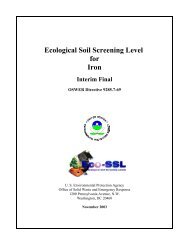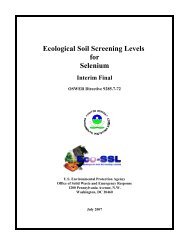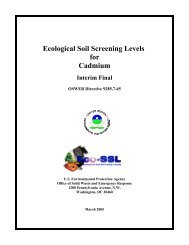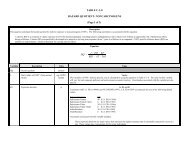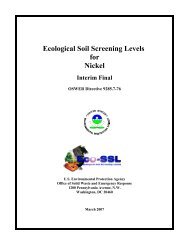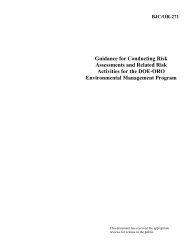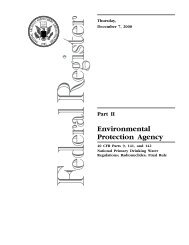Understanding Variation in Partition Coefficient, Kd, Values Volume II
Understanding Variation in Partition Coefficient, Kd, Values Volume II
Understanding Variation in Partition Coefficient, Kd, Values Volume II
Create successful ePaper yourself
Turn your PDF publications into a flip-book with our unique Google optimized e-Paper software.
is actually less than 1, and such circumstances are thought to be caused by anion exclusion (See<br />
<strong>Volume</strong> I, Section 2.8). Knowledge of the K d and of media bulk density and porosity for porous flow,<br />
or of media fracture surface area, fracture open<strong>in</strong>g width, and matrix diffusion attributes for fracture<br />
flow, allows calculation of the retardation factor. For porous flow with saturated moisture conditions,<br />
the R f is def<strong>in</strong>ed as<br />
where p b = porous media bulk density (mass/length 3 )<br />
n e = effective porosity of the media at saturation.<br />
R f = 1 + (p b/n e )K d (2.3)<br />
The K d parameter is valid only for a particular adsorbent and applies only to those aqueous chemical<br />
conditions (e.g., adsorbate concentration, solution/electrolyte matrix) <strong>in</strong> which it was measured. Sitespecific<br />
K d values should be used for site-specific contam<strong>in</strong>ant and risk assessment calculations.<br />
Ideally, site-specific K d values should be measured for the range of aqueous and geological conditions<br />
<strong>in</strong> the system to be modeled. However, literature-derived K d values are commonly used for screen<strong>in</strong>g<br />
calculations. Suitable selection and use of literature-derived K d values for use <strong>in</strong> screen<strong>in</strong>g calculations<br />
of contam<strong>in</strong>ant transport is not a trivial matter. Among the assumptions implicit with the K d construct<br />
is: (1) only trace amounts of contam<strong>in</strong>ants exist <strong>in</strong> the aqueous and solid phases, (2) the relationship<br />
between the amount of contam<strong>in</strong>ant <strong>in</strong> the solid and liquid phases is l<strong>in</strong>ear, (3) equilibrium conditions<br />
exist, (4) equally rapid adsorption and desorption k<strong>in</strong>etics exists, (5) it describes contam<strong>in</strong>ant<br />
partition<strong>in</strong>g between 1 sorbate (contam<strong>in</strong>ant) and 1 sorbent (soil), and (6) all adsorption sites are<br />
accessible and have equal strength. The last po<strong>in</strong>t is especially limit<strong>in</strong>g for groundwater contam<strong>in</strong>ant<br />
models because it requires that K d values should be used only to predict transport <strong>in</strong> systems chemically<br />
identical to those used <strong>in</strong> the laboratory measurement of the K d. <strong>Variation</strong> <strong>in</strong> either the soil or aqueous<br />
chemistry of a system can result <strong>in</strong> extremely large differences <strong>in</strong> K d values.<br />
A more robust approach than us<strong>in</strong>g a s<strong>in</strong>gle K d to describe the partition<strong>in</strong>g of contam<strong>in</strong>ants between the<br />
aqueous and solid phases is the parametric-K d model. This model varies the K d value accord<strong>in</strong>g to the<br />
chemistry and m<strong>in</strong>eralogy of the system at the node be<strong>in</strong>g modeled. The parametric-K d value, unlike<br />
the constant-K d value, is not limited to a s<strong>in</strong>gle set of environmental conditions. Instead, it describes the<br />
sorption of a contam<strong>in</strong>ant <strong>in</strong> the range of environmental conditions used to create the parametric-K d<br />
equations. These types of statistical relationships are devoid of causality and therefore provide no<br />
<strong>in</strong>formation on the mechanism by which the radionuclide partitioned to the solid phase, whether it be by<br />
adsorption, absorption, or precipitation. <strong>Understand<strong>in</strong>g</strong> these mechanisms is extremely important<br />
relative to estimat<strong>in</strong>g the mobility of a contam<strong>in</strong>ant.<br />
When the parametric-K d model is used <strong>in</strong> the transport equation, the code must also keep track of the<br />
current value of the <strong>in</strong>dependent variables at each po<strong>in</strong>t <strong>in</strong> space and time to cont<strong>in</strong>ually update the<br />
concentration of the <strong>in</strong>dependent variables affect<strong>in</strong>g the K d value. Thus, the code must track many<br />
more parameters and some numerical solv<strong>in</strong>g techniques (such as closed-form analytical solutions) can<br />
2.2



